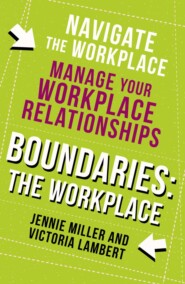По всем вопросам обращайтесь на: info@litportal.ru
(©) 2003-2024.
✖
Boundaries: Say No Without Guilt, Have Better Relationships, Boost Your Self-Esteem, Stop People-Pleasing
Настройки чтения
Размер шрифта
Высота строк
Поля
What parent doesn’t know the patter of small sleepy feet when your child is coming in for a midnight cuddle, story, glass of water, or other excuse to see Mummy and Daddy?
Keeping your child out of your bed may be a tough self-boundary as you respond to an almost primeval need to protect the young. But caveman parents didn’t have to set an alarm, get children to school, commute to an office and then spend a day full of reports, meetings and office politics. You don’t have the luxury of time, however, you do have the greater luxury of safety. You don’t need to be on high alert 24/7 to protect your child from hungry bears.
Ask yourself if you need to be either in the same room as your child, or sleeping with one ear open in case they need you to pay a visit to them. Stand back and look at 365 days a year. Realistically, how often is a child going to need you in the night? Unless they have a chronic condition or a serious illness, the chances are that it will be just a handful of nights. Yet many parents feel and behave as though the call could come at any time every night. Notice the difference between reality and fantasy. Think, too, how much better it would be for the whole family if – should illness occur – a parent is already rested.
We’re going to look at sleep boundaries for children later on in the book. For now, though, the key to keeping children in their own beds is consistency. When a child invader comes in, be calm and reassuring as you take them back to their bed firmly but with kindness. Be consistent in your parenting and do give it time. A few weeks at least to re-establish good habits for all the family. Be patient and remember that it wouldn’t be fair to your child to break the new boundary and let them sleep in your bed one night a week or when your partner’s away. Note your reaction to this – are you feeling defensive?
Do notice the first time you get a good night’s sleep and congratulate yourself on establishing a well-held boundary. Some are tougher than others to put in place.
But children are not the only nocturnal visitors or additional bed guests. You may feel that the comfort you get from allowing a trusted pet companion to share your sleeping space helps you to nod off. But, if you are having sleepless nights, Fido may be to blame.
Vets warn that animal nocturnal behaviour is not compatible with the human sleep cycle – cats, for example, may wake you in the small hours for food or company as this suits their natural biorhythms. Interestingly, dogs may see the bed as their territory and push you to the edges as they stretch, scratch and snore. Your dog here is the one with the strong self-boundary as he or she has claimed the territory of the bed as their own and is defending it to the detriment of your sleep. How often have we heard pet owners ‘jokingly’ recount nights spent curled up at the edge of the bed while their Alsatian stretches out in luxury? They may then shrug and say, ‘What can you do? I wouldn’t be able to sleep without him.’
If this is you, put the question of pets in your bed to your internal debating table. Which is the loudest voice at the table? Is it the Parental part of you, which has turned Fido into a substitute or additional child and worries about him feeling neglected or lonely if kept in another room? Is it your rebellious voice – maybe responsible for that defensive feeling mentioned earlier – saying, ‘My parents wouldn’t let me have a pet, so I am going to love this one however I choose and break all their rules’? Or, is it your anxious Child, who wants both the comfort of the living cuddly toy and the protection the dog represents against potential burglars or even monsters in the night?
Listen to the voices but now challenge what they are saying. If Fido is there for comfort, but you are not sleeping well, how much good is that doing you? If you are sleeping eight good hours a night, that comfort would not be so necessary.
Draw the Line:good self-care doesn’t equal self-spoiling. It’s not about indulging yourself but taking mature decisions.
We’re going to assume that a mature dog or cat or a young animal can be trained. First, create a comfy sleeping area for them in a separate room well away from your own bedroom. Be consistent with not allowing them to sleep anywhere else. If they try to join you, cry or chew, be calm and reassuring but don’t give in. As with re-training children at night, do give it time. Be persistent and consistent. If this isn’t enough, you may want to bring in a dog behaviourist to help.
Or is it your beloved keeping you awake? This may be through sleep talking, snoring, restlessness, duvet-hogging, hot flushes, early starts, or late nights. It may not be a new problem – but just because their sleeping behaviour is entrenched in your family bed there is no reason to put up with its consequences. All these problems have a root cause so that’s where you’ll find your sleep solution.
Sleep talking: if this is the problem, don’t wake them up when it is happening. Reassure them in their sleep that everything is OK. Sleep talking is often the result of an anxious brain processing during the night. Talk to them about what might be troubling them and suggest that they write down their worries before they go to sleep. Through talking they may realise there is a problem to address, and want to get some outside help.
Persistent snoring: this needs a chat with the GP to assess physical symptoms as snoring can be a sign of sleep apnoea and other breathing difficulties. A doctor may suggest lifestyle changes such as weight loss or interventions including day surgery. Perhaps this sounds like something which might lead to a row, with the non-snorer suffering guilt and the snorer feeling shame and resentment? But there is nothing wrong with caring for yourself and others, and this is a classic example of such a moment. By encouraging your snoring partner to seek help, you could well be encouraging them to make a dramatic improvement to their health overall. The peace at night is a beneficial by-product to the relationship as a whole – and who could argue with that?
Restlessness: this can be caused by lifestyle issues such as caffeine consumption, not enough exercise, weight issues, or too much alcohol. This is a good example of where your self-boundaries can be weakened by someone else’s lack of boundaries. We’ll come back to this later in the book, but for now ask your partner what they can do to improve any/all of these areas.
Duvet hogging: get two duvets.
Hot flushes (for you and/or your partner): having your own duvet will help. A fan is useful, as is bedding made of natural fibres, including silk. Talk to your GP about natural ways to support the menopause and discuss whether hormone replacement therapy (HRT) might be right for you or your partner.
Early starts or late nights: shift work can take a toll on many relationships because it does disturb everyone’s sleep. Simple tricks like leaving clothes for the next day in another room and minimising all chances of disruption can help. Sleep masks can be useful too. Conversations and mutual consideration are key.
Draw the Line:self-boundaries don’t just mean being firm with ourselves, but with others. Sometimes the greatest threat to you building a strong set of self-boundaries comes from the person you love most.
You’ll notice how in order to achieve your sleep self-boundary in a situation where you share your bed, your co-sleeper will have to put some boundaries in place too. Whether this means addressing their own health, their attitude to bedtime, or talking about their feelings more, your partner’s self-boundary is linked to yours. Throughout the book, there will be examples of this and sometimes you will find this challenging. Our self-boundaries are crucial to our personal wellbeing but they will have an effect on those closest to us. This is not a reason to give up as the case history on fitness in the next section shows.
EXERCISE: Simple Body Scan(Listen to this exercise here)
Trouble getting to sleep or maybe you suffer from 3 a.m. wakefulness? With time, this will help you to relax and head off to the Land of Nod.
Practice this during the day when you can be on your own and not disturbed. Either lying in your bed or on a sofa, take a few breaths, settle yourself and close your eyes.
Now imagine a light above your body. It can be any colour you find comforting – white, lilac, gold – and it can be warm or cool as suits your surroundings and mood.
Start at your toes and visualise the light moving slowly up to your head and back down again, relaxing each muscle as you go. As it shines on different parts of your body, mentally and physically relax the muscles there.
Allow yourself to sink into the bed and breathe slowly and deeply as you drift into sleep.
Setting your sleep boundaries will start a virtuous circle. Engaging that considered voice – which has listened to all your internal opinions – when considering self-boundaries will help you to rest. Being more rested will allow you to engage that voice again when you need to review another self-boundary. Overall, be kind to yourself and know that rest is good. Take the pressure off.
Now go to your Learning Journal and note the sleep self-boundaries you can start to work on.
Fitness (#ulink_b2204635-504d-5768-8648-c764e2063c88)
In this section, we’ll introduce the self-boundaries you need to implement around exercise.
Ask yourself this: what was your reaction to reading the section sub-heading ‘Fitness’? Did you want to skip this section? Perhaps you thought you didn’t need to read it, or were afraid – not just of what it might say but how it might make you feel?
Write this feeling down. Which inner voice is talking, do you think? Perhaps it is a lofty, ‘I don’t need this,’ which sounds a bit like a Parent talking. Or maybe, ‘This feels exciting; I love running around,’ which is like a Child. An Adult response would be ‘I wonder what I can learn from this,’ however experienced or motivated you already are.
We’re all aware these days of how vital it is to get and maintain fitness. Numerous studies have shown the benefits of regular exercise for cardiovascular and mental health. But, how do you draw the line between managing your body for optimum, age-related health and becoming either too overwhelmed to start or too obsessed to stop? Those who develop a fanatical approach to fitness have self-boundaries which are just as weak as those who do no sport. The healthy position lies between the two and is the one that comes with positive self-boundaries – knowing how much and how often to exercise so that your fitness will improve but not dominate your life and relationships.
First, decide how fit you need to be to care for yourself. We would advise visiting your GP practice before taking up a new exercise regime, especially if you are aged over 50. That may mean blood pressure, cholesterol and blood sugar level testing. You may consider yourself to be in good shape but don’t take that for granted. Inherited cholesterol issues affect slim people as well as those who are heavier; and doctors have also warned about the development of internal fat around organs, which is believed to be more dangerous for your health than a little extra visible fat on your thighs.
You could use a gym to have an assessment with a personal trainer. You may prefer to use a monitoring wristband – like a Fitbit or Nike+ FuelBand. Or you could check your BMI against NHS guidelines – and at the same time, count your daily steps to see how close they are to the recommended daily 10,000. You could also try timing how long it takes to walk to a set point. These tests and measures will give you a practical idea of how fit you are and what you might want to do, but some people will still find it difficult to build and maintain a self-boundary around fitness.
BRING IN THE BOUNDARIES:
Your Fitness Plan
Whatever your current state – couch potato or marathon runner – here are some ways to improve your self-boundary towards a healthier state of fitness.
Take the Adult position and say, ‘What can I learn that might make a difference to me?’
Note down three things you might like to change. These could be: ‘I just want to get off the sofa’; ‘I don’t want to let fitness run my life’; or ‘I want to get moving for the sake of my aching back or stiff joints’.
Getting your body into a healthy condition can be done in lots of ways. Gyms and running are not for everyone – nor do they have to be. Not all fitness has to be competitive either. If you find sport intimidating for that reason, perhaps you might consider Tai Chi or something in a group, like line dancing. Think of a long-lost passion – such as horse riding – could you do that again? Get out of the mindset that fitness has to look a certain way and/or equal slog.
How much time can you give to fitness weekly? Whatever you choose needs to fit in with the time available, rather than you squeezing a busy schedule tighter – which will give you an excuse to fail.
The same can be true for cost and/or facilities. If you live miles from a town, don’t pressure yourself to join a gym you may find hard to visit. The answer might lie in a pedometer.
Draw the Line:set yourself up for success, not failure. But if you do step backwards, don’t give up hope. The boundary is still in place, it just needs a little more attention.
Buddy systems have their uses, but a self-boundary isn’t one you can share. If your buddy falls by the wayside, it can be difficult not to follow suit. Enjoy company if it helps with your motivation, but don’t let it be your only motivation.
At all times be wary of following in other people’s footsteps, particularly your parents’ or those of other important individuals in your life. If you instinctively don’t want to do a type of exercise, ask yourself why. Did your mum, dad, or sibling do it so well that you feel you can never compete? In which case, understand that you don’t have to do this to participate at their level – you can just be yourself and enjoy it.
Self-boundaries can be challenged by our relationships with our emotional partners; however, they are not the only threats to our self-care. The challenge could equally well come from parents, friends, or children, even if they don’t realise they are affecting our personal decisions.
CASE HISTORY
This example highlights the impact those around us have on our boundaries: Liam and Grace came to Jennie’s practice together with a familiar problem of miscommunication. But as Jennie began to work with them, one issue popped up which turned out to be quite typical of their relationship. They seemed unable to create secure healthy self-boundaries which didn’t leave the other person feeling excluded. Both were so focused on ‘caring’ for their relationship, they had no time or mental space to ‘care’ for themselves.
The couple explained to Jennie that every New Year’s resolution for the past half-decade would be to join the local gym and get fit. Both had a history of type 2 diabetes in the family, and as they approached middle age, they were keen to avoid that illness, and indeed any others. Both regularly moaned to each other about thickening waistlines and feeling a bit sluggish.









